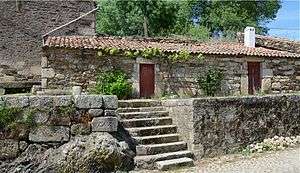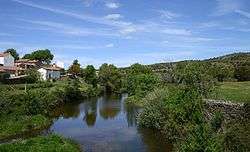Idanha-a-Velha
| Idanha-a-Velha | |
|---|---|
| Parish | |
|
View of the village, with River Ponsul | |
| Country | Portugal |
| Municipality | Idanha-a-Nova |
| Disbanded | 2013 |
| Area | |
| • Total | 20.98 km2 (8.10 sq mi) |
| Population (2001) | |
| • Total | 79 |
| • Density | 3.8/km2 (9.8/sq mi) |
| Website | www.cm-idanhanova.pt |
Idanha-a-Velha is a village and a former civil parish in the municipality of Idanha-a-Nova, Portugal. In 2013, the parish merged into the new parish Monsanto e Idanha-a-Velha.[1] It covers an area of 20.98 km² and had a population of 79 as of 2001.
History

As one of the oldest towns in Portugal, with a history of Roman settlement recorded since the year 16 AD,[2] Idanha-a-Velha has been described as a "modest village with a rich historical background".[3] Idanha-a-Velha is built on the site of the city of Egitânia, which previously had thousands of inhabitants. The town was repeatedly invaded and looted throughout history, and the ruins evince the influence of different periods of its history: buildings from the Pre-History, Celtic, Roman Classicism, Suebic, Visigothic, Arabic, Middle Ages and Portuguese Manueline periods.
The town is reputed to have been the birthplace of the famous Visigothic King Wamba,[3] as well as the fourth century Saint Pope Damasus. The Visigoth King Roderic is also said to have been buried here.
The town is host to a restored 16th century church, called "the Cathedral",[4] built on ruins dating from the time of the Suebi, as far back as to the fourth century — the first Visigothic cathedral built on the Iberian Peninsula.[2] The inside of the cathedral holds the largest collection of Roman epigraphs in Europe,[2] refurbished as a modern museum to contain the carved and inscribed Roman stones.[3]
There is also a 17th-century pillory in the village square.[3] Nearby stand the ruins of a Torre dos Templários, a tower constructed on the ruins of a Roman temple dedicated to Venus.[3]
References
- ↑ Diário da República. "Law nr. 11-A/2013, pages 552 58-59" (pdf) (in Portuguese). Retrieved 23 July 2014.
- 1 2 3 "Idanha-a-Velha". Freguesias (in Portuguese). Câmara Municipal de Idanha-a-Nova. Retrieved 2008-02-28.
- 1 2 3 4 5 "Castelo Branco". Portugal Travel. Retrieved 2008-02-28.
- ↑ "Catedral Visigótica de Idanha-a-Velha". Visit Portugal. 2006. Retrieved 2008-02-28.
External links
| Wikimedia Commons has media related to Idanha-a-Velha. |
Coordinates: 39°59′49″N 7°08′38″W / 39.997°N 7.144°W
